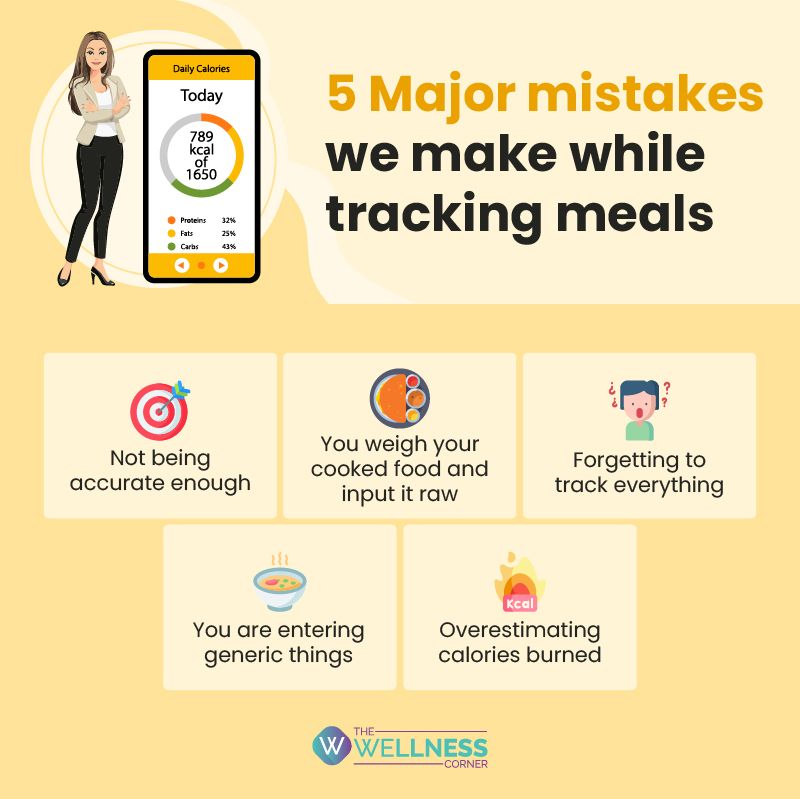Major Mistakes We Do While Tracking Meals
- 23 months ago
Tracking meals is a great way to keep an eye on your diet and track the calories and macronutrients you take in to stay healthy. However, many people make mistakes while tracking their meals, leading to inaccurate or incomplete data.
In today's world, where we are bombarded with a constant stream of information about what we should or should not eat, tracking our meals has become an essential tool for maintaining a healthy diet. With the help of technology and various apps, tracking meals has become more accessible than ever, allowing people to keep track of their nutrition intake, set goals, and make informed decisions about what they eat.
Despite its popularity and usefulness, many people make mistakes while tracking their meals, leading to inaccurate or incomplete data. These mistakes can range from not tracking everything they eat to not measuring portions accurately or not reading food labels.
In this blog, we will explore some major mistakes people make while tracking their meals and how to avoid them. We will also discuss the benefits of tracking meals and how they can help you achieve your health goals.
[Related: Proven-You are what you eat!]
How to track meals?
Tracking your meals involves recording everything you eat and drink to monitor your nutrient intake and achieve your health goals. To start tracking your meals, you need to determine your goals and choose a tracking method that works best for you, such as a mobile app. Record everything you eat and measure your portions accurately using a food scale or measuring cups and spoons.
Most meal-tracking apps automatically calculate your nutrient intake based on the foods you log, allowing you to track your macronutrients and calories intake. Review your data regularly to identify patterns and make adjustments to your diet as necessary. By following these steps and using a meal-tracking app, you can accurately track your meals and make informed decisions about what you eat to achieve your health goals.
[Also check: Look for these things in a diet & nutrition tracking app]
Benefits of meal tracking
Here are some benefits of meal tracking:
- Meal tracking might help you become more conscious of what and how much you are eating. It can also help you in noticing patterns in your eating habits and identify opportunities for improvement.
- Keeping track of your food intake can help you manage your portion sizes. You may be more likely to eat appropriate serving sizes and avoid overeating when you know what you are consuming.
- Meal tracking can hold you accountable for your food choices. Knowing that you need to record everything you eat may motivate you to make healthier choices.
- Meal tracking can help you set and achieve nutrition goals.
- Meal tracking can help you identify triggers that lead to unhealthy eating habits.
- Meal tracking can help you identify which foods make you feel your best and which do not. This information can help you create a personalized nutrition plan that works for your body.
5 Major mistakes we make while tracking meals

Mistake 1: Not being accurate enough
One of the biggest mistakes people make when tracking meals is not being accurate with their measurements. It can include underestimating portion sizes, forgetting to track certain foods or ingredients, or not using the right tools to measure food quantities.
To correctly measure portions, measuring cups, spoons, and food scales must be used. You should also keep track of all the ingredients you use in a meal, including any oils, dressings, or sauces.
Mistake 2: You weigh your cooked food and input it raw
Another common mistake people make when tracking their meals is weighing their food after it has been cooked and then inputting the raw weight into their tracking app. It can lead to inaccurate tracking and an overestimation of your calorie intake.
When you cook food, it can lose moisture and weight, affecting its nutritional content and calorie count. Therefore, it is essential to weigh your food after cooking it and input the cooked weight into your tracking app.
If the nutrition information for the food you are eating is only available for the raw weight, you can use a food tracking app that allows you to adjust the serving size based on the cooking method.
Mistake 3: Forgetting to track everything
Forgetting to track everything refers to the common mistake of not logging all the food and drinks consumed throughout the day. It can include small snacks, condiments, beverages, and even the oil used for cooking. When you forget to track these items, it is difficult to get an accurate picture of your overall calorie and nutrient intake.
You may forget to log the handful of nuts you had as a snack or the tablespoon of salad dressing you added to your salad. These seemingly small items can add up over time and contribute to an inaccurate assessment of your daily calorie and nutrient intake.
Mistake 4: You are entering generic things
Another common mistake people make when tracking their meals is entering generic or vague descriptions of the foods they eat, instead of being specific. For example, instead of entering vegetable soup, it is better to enter the specific ingredients used, such as carrots, celery, onion, and chicken broth.
By being specific with your food descriptions, you can get a more accurate picture of your nutritional intake. It will also help you identify potential areas for improvement in your diet, such as not getting enough protein or consuming too much sodium.
Mistake 5: Overestimating calories burned
Many people make the mistake of overestimating the calories they burn during exercise. It can lead to overeating or consuming more calories than you burned, which can stall your progress.
To avoid making this mistake, use a heart rate monitor or fitness tracker to calculate the calories you burn while exercising. You should also be modest with your calorie calculations and not assume you burned more than you did.
[You may also like: Track your health: 10 Tools to keep yourself healthy]
Conclusion
Tracking meals can be a powerful tool for achieving your health and fitness goals, but it is essential to avoid common mistakes that can undermine your efforts. You can improve the accuracy and effectiveness of your meal tracking and avoid common pitfalls like failing to measure portion sizes, ignoring hidden calories, and neglecting to track condiments and beverages.








